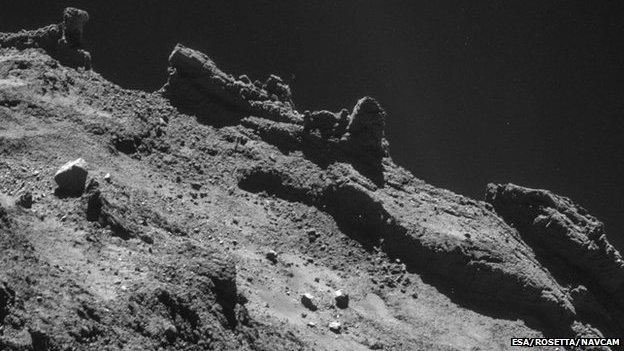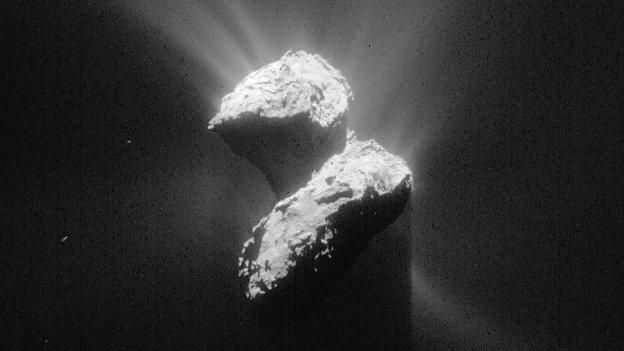Controllers wait on Philae link
- Published

Philae will provide valuable information about the landscape of comet 67P
No new signals have been picked up from the Philae comet lander since a brief radio contact on Sunday.
European Space Agency (Esa) controllers listened again on Tuesday night but heard nothing.
This was not surprising, they said, given the less than ideal conditions for a radio connection.
Philae called home from Comet 67P on Saturday, its first contact since running out of battery power shortly after landing some seven months ago.
The communication was short - just 85 seconds - and was then followed by an even briefer link-up on Sunday.
The robot's mothership Rosetta, which dropped the robot on to the 4km-wide icy dirt-ball, is now being moved closer to facilitate a more effective relay.
Currently, the satellite is sitting back from the comet at a distance just above 200km.
Controllers have commanded Rosetta to get as close as 180km. They have also told the probe to keep its antenna pointing directly down to aid a stronger radio connection.
Treacherous flying
The mission has to be cautious, though. Comet 67P is throwing huge quantities of gas and dust into space as its ices melt in the warmth of the Sun.
If controllers are not careful, this blizzard of material will confuse Rosetta's navigation systems, potentially tripping the probe into a protective "safe mode" that shuts down all but essential functions.
This would make communication with Philae impossible but also risk putting Rosetta in some danger because it would no longer be under full control.
"It's like flying your car in a snowstorm. You don’t see anything, and that's quite dangerous," said Elsa Montagnon, Esa's Rosetta deputy flight director.
"It's the same for Rosetta. Its 'eyes' – its star-trackers, which it uses for autonomous orientation - rely on finding stable star patterns that they can follow.
"And in this very dusty environment, the trackers can mistake dust particles sometimes for stars and that can lead the spacecraft in the wrong direction."
Barbara Cozzoni: "We will start with low-cost, low-risk science"
The immediate plan is to fly Rosetta over the comet in a way that repeats the communication conditions experienced on Saturday.
If a stable connection can be established, "housekeeping data", known to be held on the lander detailing its health, can be downlinked, and new commands uploaded.
Already, engineers can see from their brief conversations with Philae that it is in good shape.
Its onboard systems appeared to experience no damage during its long slumber and are all working.
Critically, the robot's internal temperature is rising and this should soon allow it to start charging its battery system.
For the moment, however, its working day is limited to about three hours of every 12.4-hour "comet day" when sunlight falls on its solar generator.
Elsa Montagnon: "Making contact is really quite a challenge"
"For some operations, we do need the battery," explained Barbara Cozzoni, a lander engineer from the German space agency.
"The power from the solar arrays is not sufficient, on its own, to drill and analyse cometary samples, for example."
This means the first block of science to be conducted by the awakened Philae, once it can be commanded on a stable link, will involve no mechanical movements.
These first experiments will measure simple parameters like the magnetic and thermal environment around the lander.
Once higher power conditions can be attained, Philae will be told to take some new pictures of its surroundings, and "sniff" the chemical compounds that are wafting past it.
And eventually, Philae will hopefully get sufficient power in its battery to drill into the comet and analyse its make-up.
The washing machine-sized robot landed on Comet 67P on 12 November, and worked for about 60 hours before its primary battery ran flat.
It emerged that on touchdown, Philae had bounced into a dark ditch, with high walls stopping sunlight from reaching its solar panels.
It is only now - seven months later, as the comet has moved closer to the Sun - that illumination conditions have improved to the point where the robot can once again talk to Earth.
- Published15 June 2015

- Published14 June 2015

- Published14 June 2015
